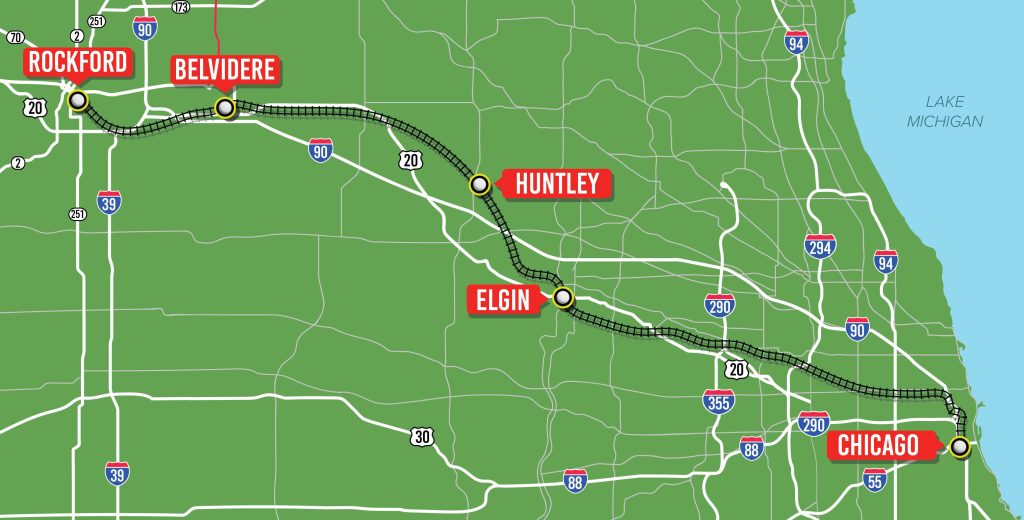For 20 years, Rockford, Belvidere and Huntley have dreamed of passenger rail service to Chicago. At long last, it’s within reach.
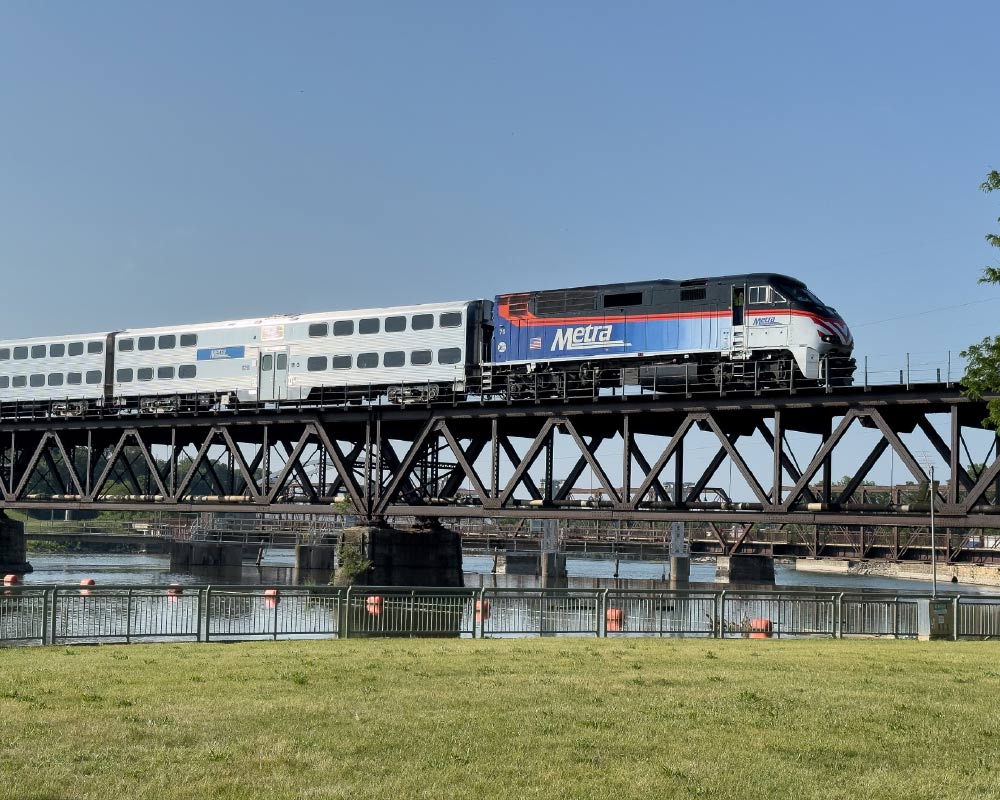
Stop if you’ve heard this one before: Passenger rail service is coming to Rockford.
Well, this time, it’s for real. Almost.
When the first locomotive arrives in downtown Rockford in 2027, it closes an odyssey that’s been filled with false starts, near-misses and more twists than a Hollywood thriller.
According to local officials, this time things are different. The money’s there, they say. The work is starting, they say. The timetable is set, they say.
But the skeptics still have their doubts. Is it really happening?
“Yes, it is,” says Elliot Ramos, bureau chief of passenger rail corridor management for the Illinois Department of Transportation (IDOT). “We have clear direction from the governor and a clear appropriation through the General Assembly through Rebuild Illinois to move this project forward. We have embarked on this task and are working with our project partners. We are full steam ahead to getting rail service to Rockford starting in 2027.”
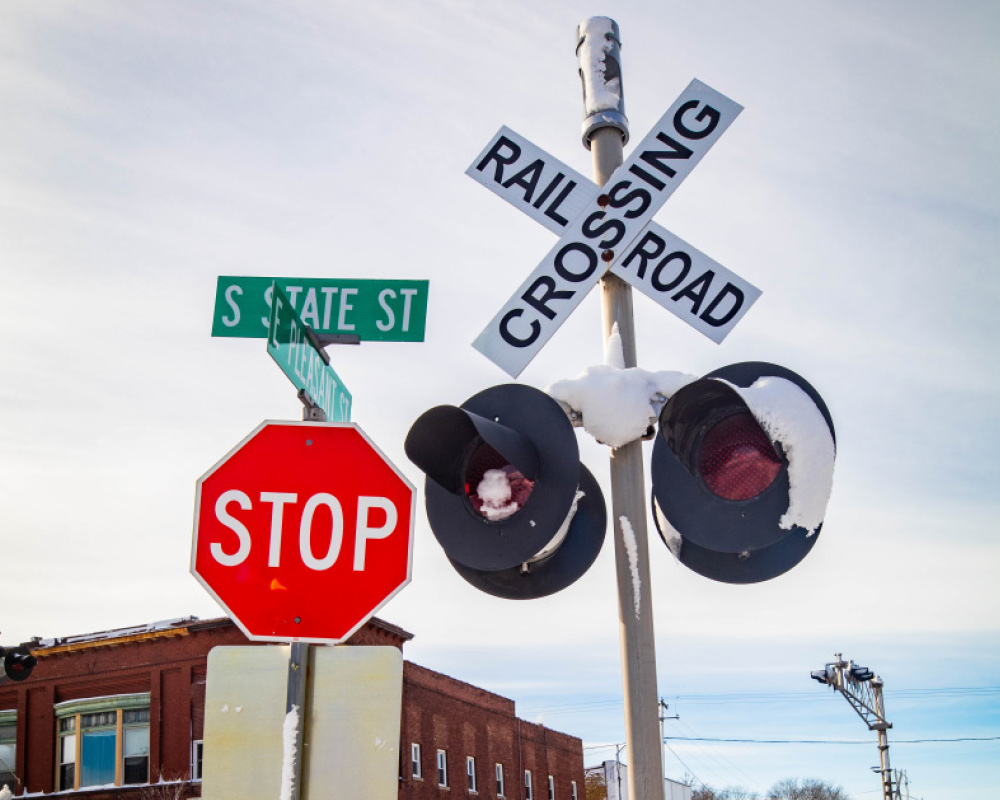
What We Know
It was a sunny day in July 2023 when a Metra train pulled into downtown Rockford and parked itself over the Rock River for the big announcement: Chicago’s commuter rail line would bring passenger trains to Rockford.
Of course, the bigger news had come four years earlier, in May 2019. With the passage of Illinois’ capital bill, legislators earmarked $275 million to restart passenger service in Rockford, with enough money to support infrastructure improvements, stations and other preparations.
Current plans call for Metra to make two round trips a day starting in late 2027, with one train arriving and departing during the morning rush hour and another train arriving and departing in the evening.
From Rockford to Elgin, the route travels Union Pacific tracks to Belvidere and Huntley, until it meets Metra’s current Milwaukee District West route at Big Timber Station in Elgin. From there, the train runs nonstop to Chicago’s Union Station.
Those are the easy details. To get the trains running, IDOT officials must negotiate with the railroad, identify improvements along the track, manage costs, and prepare any additional infrastructure along the way, including additional sidings so cargo and passenger trains can coexist on the line. IDOT teams are also inspecting every section of track and every road crossing to ensure it handles the faster speeds that passenger trains travel.
“We also need to upgrade the track infrastructure – the ties and rails – and we’ll need to install a positive train control system, as required by the Federal Railroad Administration,” says Ramos, who oversees expansion projects in Illinois. “We have proposed stations in Huntley, Belvidere and Rockford, which need to be built, and we are working with Union Pacific to identify any structures that will need rehabilitation or replacement along the corridor.”
Ramos expects initial engineering to end this year so construction can begin around 2025 or 2026.
Stations in downtown Huntley, Belvidere and Rockford are still under review, but details are coming together there.
“More importantly, we need to look at what public infrastructure and public amenities need to be installed around those rail stations,” says Michael Dunn Jr., executive director of the Region 1 Planning Council, which has guided much of the behind-the-scenes planning in Rockford. “We need to consider things like parking, electric vehicle charging, food and beverage options, and shelter for inclement weather.”
Belvidere is planning a downtown station on Pleasant Street, between South State and Whitney Boulevard, after the City rejected plans for Irene Road and a block north of the current site. Mayor Clint Morris believes this present location will improve visibility, walkability and opportunity for train riders.
“If you have an opportunity to be able to court new foot traffic and customer base, it does help your downtown businesses and it helps the City of Belvidere in general,” Morris says.
Meanwhile, Rockford is preparing a different site than the one Amtrak abandoned in 1981. The City bought and demolished that station around 2010. The site is actually a block south of the planned Metra route, on a different rail line.
Currently, the City is offering land it owns on the southeast corner of Cedar and Court streets, where there’s an abandoned warehouse and a public parking lot.
And what about ridership? That’s still the biggest unknown. IDOT hasn’t released its estimates yet, but Ramos believes Illinois’ other routes indicate three target markets: college students, businesspeople and leisure travelers.
“Our Chicago to St. Louis line is one of our most ridden corridors in the state and perhaps the country,” says Ramos. “We have a pretty robust service, and we’re running 110 mph between Joliet and Alton. The station in Normal is the second most-utilized station in Illinois after Chicago’s Union Station, and that’s driven by the universities there.”
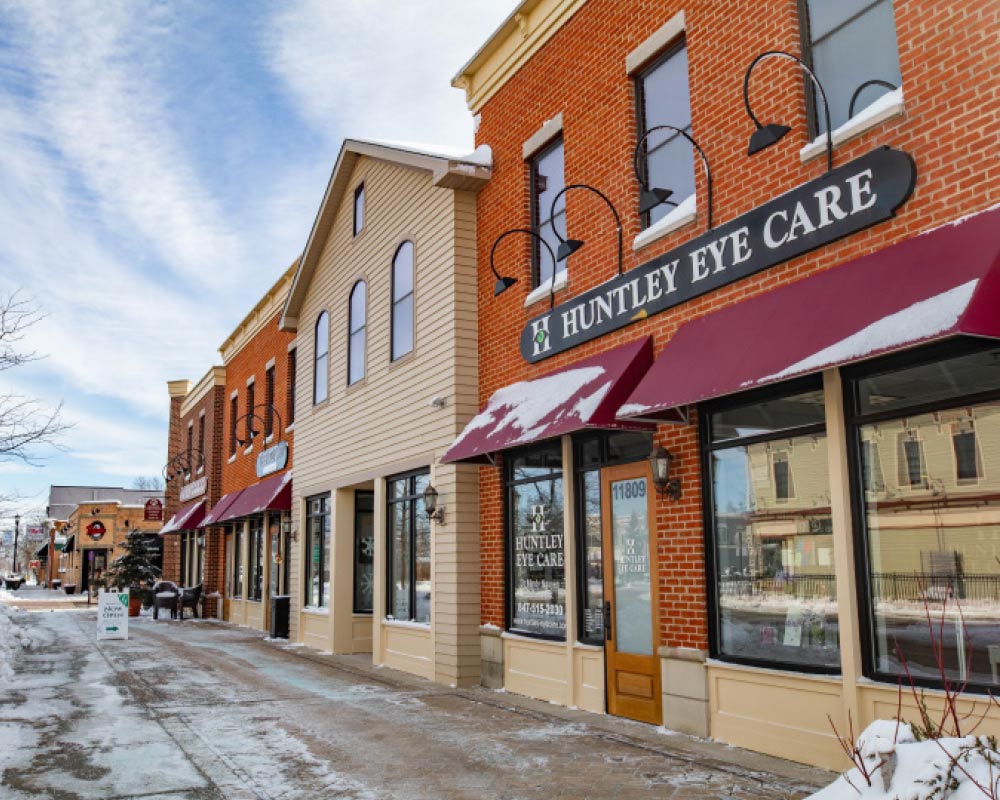
Decades of Hope
Rockford’s last passenger train rumbled out of town on Sept. 30, 1981, and for 20 years its return was only a dream. To be fair, there weren’t always fond memories of the old Black Hawk line from Dubuque to Chicago. It was notoriously late, in part because of competition with freight traffic on the Canadian National (CN) rail line, recalls Steve Ernst. The former head of Rockford Metropolitan Agency for Planning (RMAP), Ernst spent more than a decade researching, advocating and preparing for passenger rail before he retired in 2015.
The first signs of a revival came around 2002 when more than 50 elected officials pitched a new train line to the state and federal government. U.S. Senator Dick Durbin and then-Congressman Don Manzullo secured $200,000 for a feasibility study – and the results were overwhelmingly positive, Ernst recalls.
In 2006, Durbin and Manzullo secured an additional $3 million for the effort, this time as part of the federal government’s New Starts program for new rail corridors in new markets. Ernst was a City of Rockford traffic engineer and part-time regional transportation planner when he assumed ownership of the project that year. In short order, he was named full-time head of RMAP.
Amtrak released its own study in 2007, as it considered four possible routes from Chicago to Rockford and Dubuque. “Route C,” the old CN line, was Amtrak’s preferred route. It passed through Genoa in DeKalb County on its way to Rockford.
Because Ernst and his team were charged with regional transportation planning, they had their own research going. Unlike Amtrak, they found more advantages to “Route A,” the Union Pacific (UP) line through Belvidere. Additional support soon came from communities like Huntley and Marengo, where residents also wanted passenger rail service.
“The funny thing was that, all along, from day one, the UP was always very receptive to this,” Ernst recalls, “and the CN was never receptive.”
The two studies also disagreed on a target market. Amtrak’s specialty is intercity rail, which often involves infrequent arrivals at destinations a few hundred miles apart. RMAP, on the other hand, saw Census data, travel patterns, population growth along Interstate 90, and several other factors all suggesting a different need: commuter rail, a high-frequency network that’s particularly appealing to working people. RMAP’s proposal of six daily arrivals and departures meant workers from Rockford and Belvidere had easy access to Chicago jobs – and vice versa.
“We went to the Big Timber station in Elgin, which is the westernmost station on the Metra line,” says Ernst. “We went to the parking lot and did a license plate survey, so we knew how many cars in the parking lot were from Rockford and Belvidere. We had a really good handle on forecasts for ridership.”
A steady drumbeat of mayors, chairmen and legislators – even Realtors – pushed Route A, through Belvidere, as they sought funding in Washington and Springfield. The benefit, they explained, reached beyond a passenger train.
“We tried to get them to understand that an improved rail corridor on the UP also serviced things like the Chrysler plant in Belvidere,” says Ernst. “They could benefit by having improved access. So, we tried to link economic development.”
Just when things looked possible for Belvidere and Huntley, a competing faction from Ogle and DeKalb counties popped up in late 2009 and revived hopes for Route C. Disregarding the swelling coalition behind Belvidere, IDOT pitched Route C to the federal government in a failed bid to win Recovery Act funds.
“There was often this indicator that the route through Genoa would be a great thing for Northern Illinois University, but I always disputed that claim,” Ernst says. “The route through Belvidere could benefit travelers who wanted to go to O’Hare, and our route would serve them at least as well as, if not better than, the route to NIU.”
Early 2010 brought new hopes as then-Gov. Pat Quinn came to Rockford to announce he’d found $60 million to resurrect Route A – and launch it in two years. A few months later, the next hiccup developed when an IDOT consultant again resurrected the Route C approach.
With the state’s commitment still in fluctuation, the City of Rockford negotiated with CN in late 2010 to purchase 5 acres of old railyard on South Main Street, where the former Amtrak station sat abandoned between the CN and UP lines. A $3 million grant in early 2012 funded station designs and environmental cleanup for a future station and parking lot.
Time dragged on. The state’s negotiations with CN broke down, and by 2014 Quinn was back in Rockford to announce another $233 million for rail service, this time following Route A with one daily arrival and departure. The funding included rail improvements in Elgin and a new station in Rockford, this one to sit on City-owned land between the UP tracks and the Embassy Suites hotel downtown. Taking a cue from Amtrak’s platform in Normal, Ill., Rockford engineers designed the station to fit within a parking deck.
“The idea was that it would be an elevated rail line with a multi-modal parking deck and a terminal, and it could also serve the hotel,” says Dunn, who succeeded Ernst in 2015. “And then Gov. Bruce Rauner defeated Pat Quinn and he immediately canceled the Rockford project.”
The plan sat dormant until 2019 when State Sen. Steve Stadelman, of Rockford, pushed a $275 million earmark through Illinois’ infrastructure bill.
“Unfortunately, politically we’ve just not been able to get it done over the past 20 years or so,” says Stadelman, a former TV news anchor. “We’re about the only community of our size and connection to a major metropolitan area without passenger service. To me, it’s been the missing transportation component for a long time.”
There’s little discussion about routes this time around. It follows Route A – the UP west of Elgin. Any connection to Dubuque will have to wait, as the UP ends in a steel yard west of downtown Rockford. To reach Dubuque, you’d have to switch onto the Canadian National. East of Rockford, the route is settled.
“It’s too late,” says Ramos.
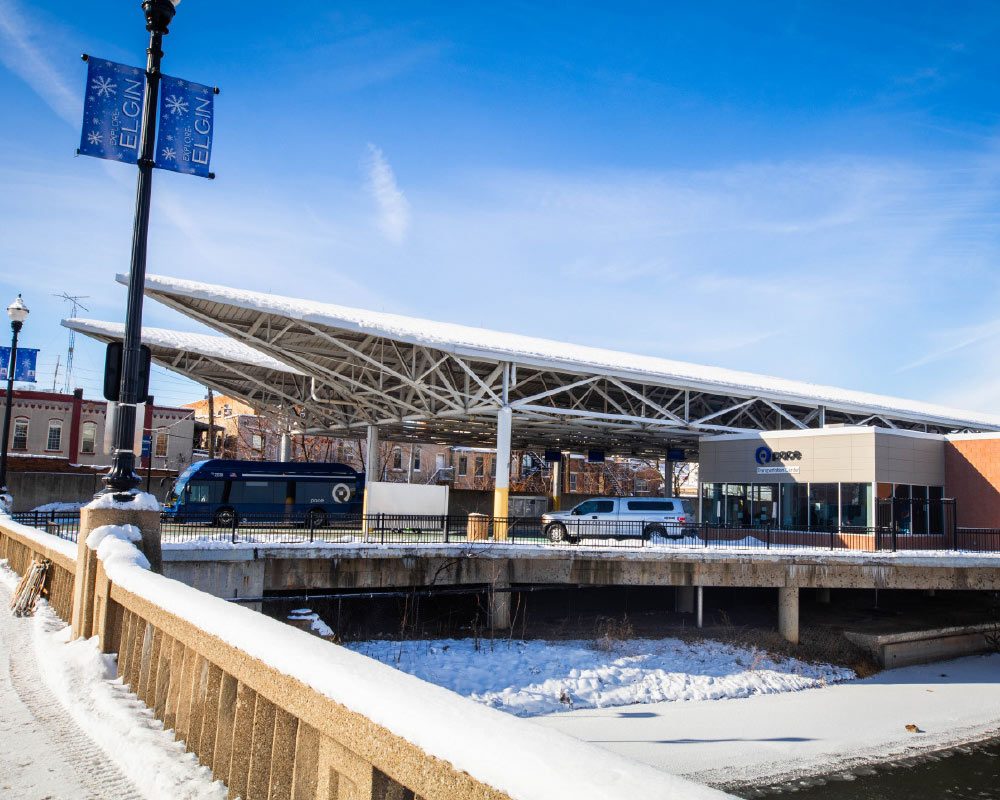
Getting to the Finish Line
Despite everything it’s taken to resurrect passenger service, there’s still one thing that can derail it all. You have to fill the seats. To do that, you need a train that comes more than once a day, at times people want to travel. And, most importantly, it should be car-competitive – a service that exceeds what you can do with a car.
“Let’s say, for example, that the train departs at 7:30 in the morning and you can be in Union Station by 9,” says Dunn. “That’s kind of car-competitive. It offers value, a benefit that attracts potential riders. That will generate more ridership, and the more ridership you can attract, the more opportunities you have for development.”
IDOT hasn’t released its ridership estimates, but Ramos says the data looks similar to Amtrak lines elsewhere in Illinois – in cities like Champaign, Carbondale and Bloomington/Normal. Where those routes differ, though, is their distance from Chicago. Metra has the advantage in Rockford, Dunn says, because it’s a commuter system in the Chicago suburbs, and it has a strong reputation for reliability.
There’s also room to expand in time. Depending on demand, that could mean a high-frequency commuter schedule or a pathway west to Dubuque, like the old Black Hawk line.
“Ridership is the key to all of this, so having additional stops west of Rockford, Rockford wins. Belvidere wins,” Dunn says. “Then, you’ll have people from the west wanting to come to Rockford.”
At this early stage, the possibilities are wide open. And they’re more promising than ever before.
“Wealth emanates from Chicago,” says Dunn. “The more we can take advantage of being just down the road from Chicago, the better we can succeed in economic development.”
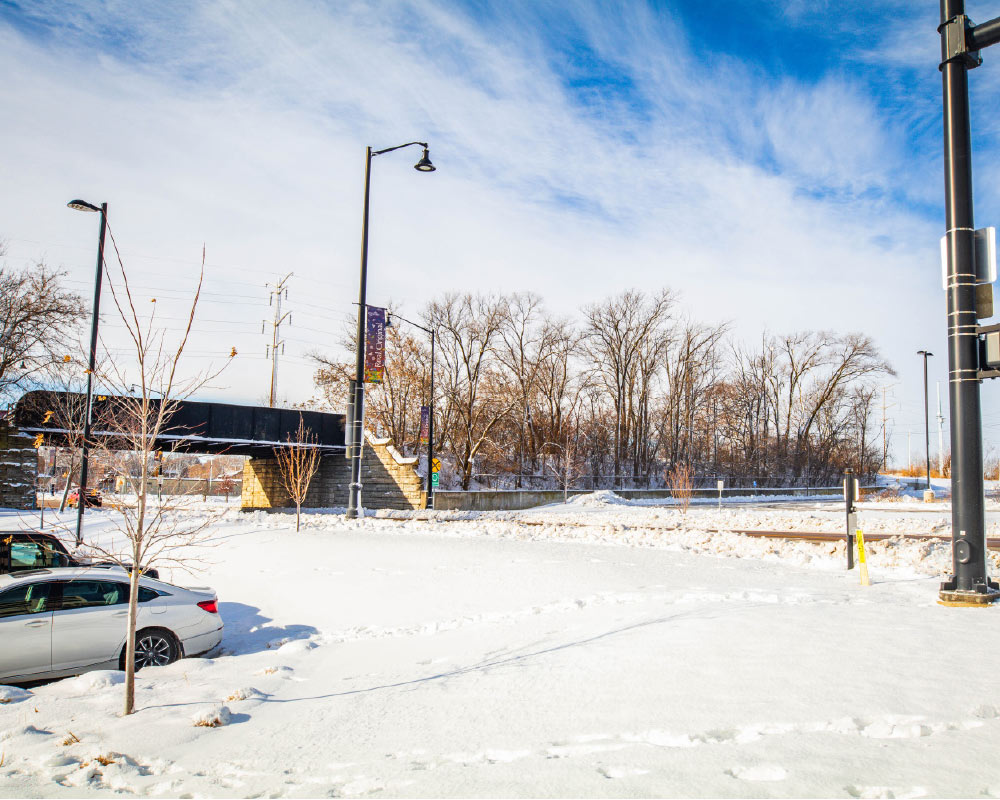
A Broader Impact
The $275 million price tag to restart rail service is a big sell for taxpayers, especially considering most passenger trains receive some level of state subsidy. But those who are closest to this project see it as a starting point for bigger things.
“These are dollars that are meant to be invested in infrastructure and transportation systems,” says Stadelman. “It’s a big price tag, but I think we all realize that transportation is key if you’re going to attract and keep new businesses, and you want to make an attractive place to live and work.”
For Belvidere, that starts with a boost to downtown businesses, who stand to gain new customers from commuters and travelers on the train. Mayor Morris also sees potential payoffs for the growing mass of industry on the UP line west of town, where two new distribution centers are rising and the Stellantis auto plant (formerly known as Chrysler) is set to receive a battery plant and parts distribution center. He also sees it as a chance to build a much-needed overpass where the UP crosses nearby Appleton Road.
“The trains have stopped traffic not only for residents and public safety vehicles but also employees of Stellantis,” he says. “Now, we’ve had development here with Walmart’s $1.2 billion investment, General Mills making a 1.3 million square-foot facility and Stellantis coming back online manufacturing automobiles. We are going to be a lot busier here, especially when you add passenger service.”
For Rockford Mayor Tom McNamara, who was born after the Black Hawk service ended, passenger rail opens up new opportunities for employment, especially given the hybrid style of work that’s been popularized with the pandemic.
“When you look at several of the initiatives we have put together in the past few years, the Metra is coming at the most perfect time for remote workers,” he says. “We will soon have fiber optic cable in front of every home, business and organization in our city. Rockford Promise will pay for every child to have free tuition for college, and soon a resident will be able to hop on the train and go into work in the suburbs or in downtown Chicago but be able to enjoy the amenities, and the affordable living, of Rockford.”
It’s not just Rockford leaders who see the potential for employment. Suburban communities see it as a way to increase access for their own businesses and residents.
“People of Elgin and the surrounding area are going to love this, because they basically get a nonstop express train to Union Station, which they’ve never had before,” says Dunn. “But we, as riders, also have options. If we’re not headed to Union Station, because we don’t have business to do in the Loop or downtown, we can get off at Elgin, hop on a local Metra train and go to any of the stops on that line. We can connect to the bus or choose whatever other mode of transportation you like: a car, a train, a plane, a bike.”
Edell Fiedler, director of communication and engagement for the City of Elgin, says city leaders see three benefits: employment access, a boost in tourism, and environmental impact from less car traffic. The train opens possibilities that Rockford residents can find jobs closer to Elgin, and vice versa, but it also attracts people to Elgin assets like the Hemmens Cultural Center, the Grand Victoria Casino and Festival Park.
“We see this as a great opportunity to increase access to the many amenities you can enjoy in our city,” says Fiedler.
Dunn’s work with transportation planning often lets him glimpse the future, as he tries to anticipate the needs of people 30 years from now. While he gets to play with ideas about connected or autonomous vehicles, he’s also watching more contemporary trends. In particular, he’s intrigued by the way real estate development accompanies high-speed rail systems like Brightline, which operates in Florida and is planning a route in Las Vegas. Brightline’s success gives Dunn hope for downtown Rockford.
“Brightline is buying blocks in Miami with the hope to develop it around a rail terminal that’s generating traffic and population growth,” Dunn says. “So, they’re in the railroad business, but they’re really in the land-development business. It’s pretty much the mother of all transit-oriented developments.”
The idea of a transit-oriented development, as he sees it, is that the train station becomes a magnet. It moves riders to their next destination, but it’s also a place for businesses to expand and people to live. It often breathes new life into underused assets.
Dunn believes it’s already starting in Rockford, thanks to developments like Colman Yards, which involves rehabbing the Barber-Colman factory, and Urban Equity Properties’ Water Power Lofts – housing that overlooks the old Amtrak station.
“If we do ridership correctly, you will see transit-oriented development and other growth around the rail terminals,” Dunn says. “And that will raise our tax base, it will create new housing for our residents – especially young professionals – and it will hopefully add to our sales tax volume. It creates better, stronger, more vibrant neighborhoods.”



















































